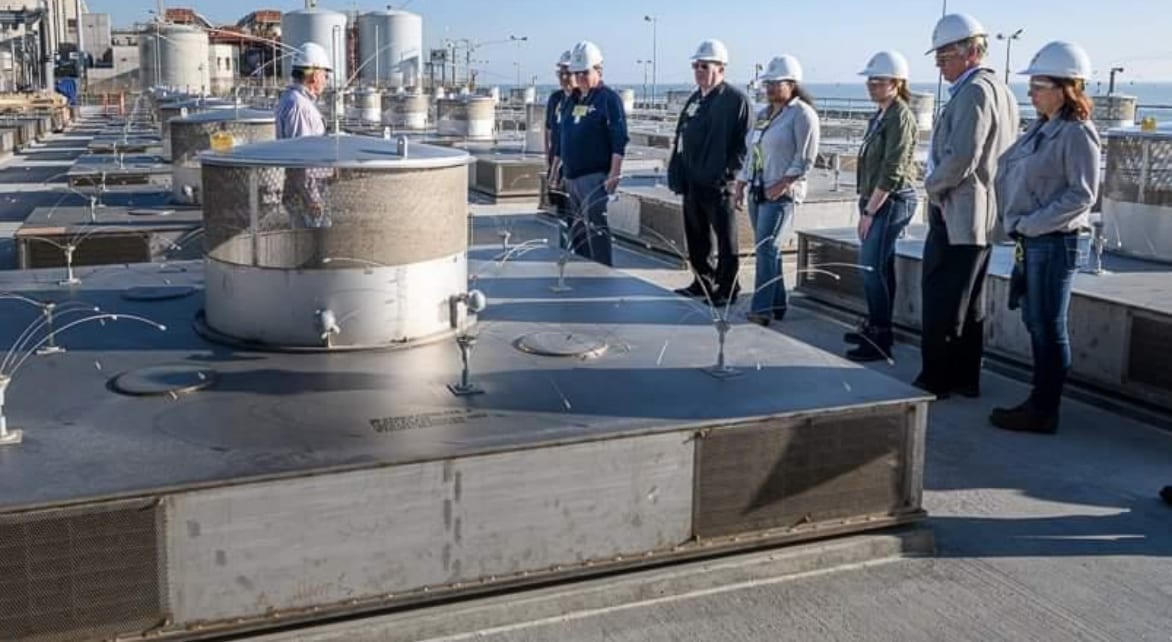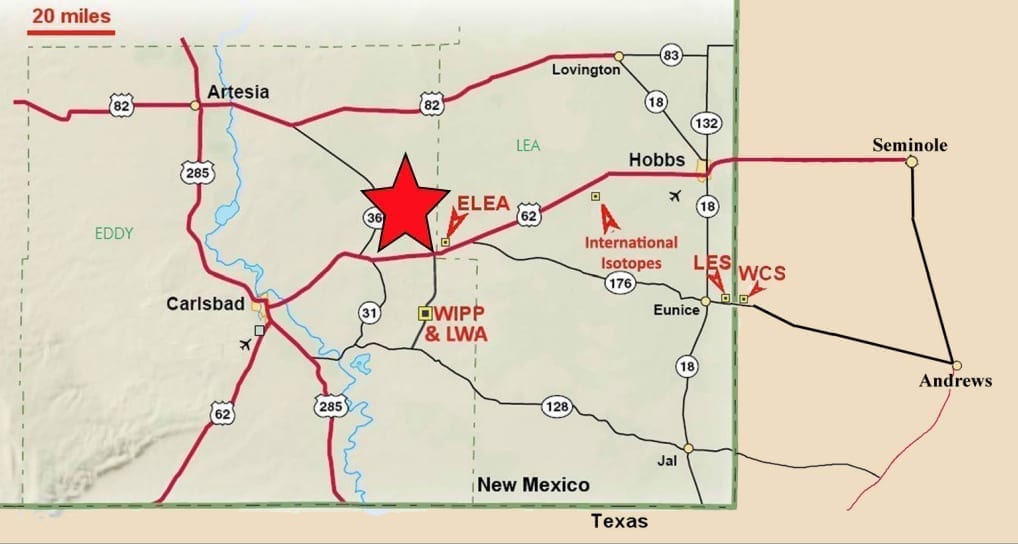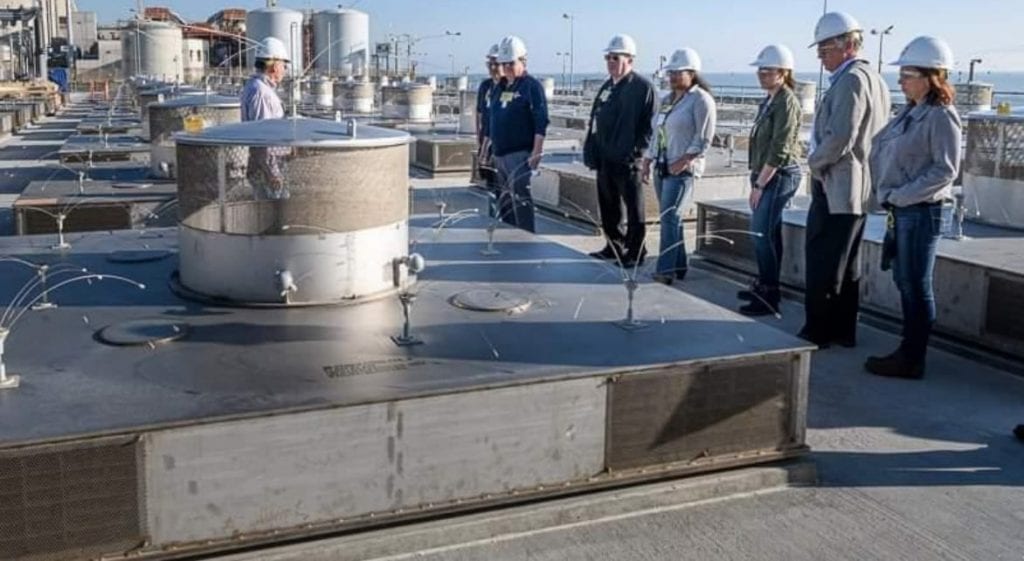New Mexico Sues NRC to Halt Consolidated Interim Nuclear Waste Storage Facilities
The post New Mexico Sues NRC to Halt Consolidated Interim Nuclear Waste Storage Facilities appeared first on POWER Magazine.

New Mexico has sued the Nuclear Regulatory Commission (NRC), challenging the legality of the agency's proceedings involving separate proposals to build and operate two consolidated interim storage facilities (CISFs) for spent nuclear fuel (SNF) in New Mexico and Texas.
In a complaint filed on March 29 against the NRC and the U.S. government, New Mexico Attorney General Hector Balderas sought a declaratory judgement and/or injunctive relief to force the agency tasked with ensuring nuclear safety and security to comply with constitutional constructs."
Balderas argued that the agency's proceedings involving Holtec International's application for a license to construct and operate a HI-STORE CISF in Lea County and Eddy County (Figure 1), and Interim Storage Partners' (ISP's) proposed CISF in Andrews County, Texas (Figure 2), are unlawful. Both projects place the substantial costs" of emergency preparation and response, as well as costs for infrastructure improvements to ship high-risk" nuclear waste on the state, tribes, and local communities, he alleged.
 1. Located between Hobbs and Carlsbad, New Mexico, Phase 1 of Holtec's proposed consolidated interim storage facility for spent nuclear fuel includes a storage facility, related buildings, and a rail line. Source: Safety Evaluation Report (Holtec, 2017)
1. Located between Hobbs and Carlsbad, New Mexico, Phase 1 of Holtec's proposed consolidated interim storage facility for spent nuclear fuel includes a storage facility, related buildings, and a rail line. Source: Safety Evaluation Report (Holtec, 2017) 2. Interim Storage Partners' proposed consolidated interim storage facility is located in Andrews County, Texas, just east of the border with New Mexico. The project site, shown here in the dark purple rectangle, will be located on a property owned by Waste Control Specialists, which operates a low-level waste storage and disposal facility in the figures shown in the green, yellow, orange, red, blue-gray, and light purple. ISP intends to expand the facility incrementally over a period of 20 years. Source: NRCA Sticking Point: The Uncertainty That CISFs Will Serve as Interim' Storage
2. Interim Storage Partners' proposed consolidated interim storage facility is located in Andrews County, Texas, just east of the border with New Mexico. The project site, shown here in the dark purple rectangle, will be located on a property owned by Waste Control Specialists, which operates a low-level waste storage and disposal facility in the figures shown in the green, yellow, orange, red, blue-gray, and light purple. ISP intends to expand the facility incrementally over a period of 20 years. Source: NRCA Sticking Point: The Uncertainty That CISFs Will Serve as Interim' StorageAt issue in Balderas' complaint filed in the U.S. District Court for the District of New Mexico on Tuesday is the Department of Energy's (DOE's) failure to fulfill mandates under the 1982 Nuclear Waste Policy Act (NWPA) to begin permanent disposal of highly radioactive SNF from the nation's reactor operators.
According to the Nuclear Waste Strategy Coalition (NWSC), an ad hoc group of public and private sector members that are collaborating to spur federal action on the issue, the DOE's decades-long default on a standard contract" to begin disposing of SNF have resulted in a de facto policy of inaction." In a letter to Energy Secretary Jennifer Granholm on March 10, the group said more than 80,000 metric tons of commercial SNF and high-level waste is currently stranded at operating and decommissioned reactor sites in 34 states without their consent."
Since 1983, about $54 billion has been credited to the Nuclear Waste Fund, including over $21 billion collected from electric ratepayers, and over $28 billion in interest that continues to accumulate at a rate of over $1.7 billion a year. The approximately $43 billion balance sits stranded in U.S. Treasury Securities and unappropriated for its intended purpose," the group said. The group urged Granholm-a former governor of New Mexico-to urgently act on resolving the nation's nuclear waste management dilemma.
However, with efforts to revive the Yucca Mountain deep geologic repository in Nevada paralyzed by a long-standing political deadlock and lack of funding commitments, only two other options are legally afforded by the NWPA. One is to use federal monitored retrievable storage (MRS) facilities, in which the DOE could store nuclear waste from commercial nuclear plants pending permanent disposal or reprocessing. Despite the DOE's attempts in the late 1980s to persuade states to host an MRS facility, no MRS facilities have been proposed.
The other NWPA option is to construct one or more interim storage facilities to consolidate SNF in willing host communities to which the DOE could move SNF until a long-term geological SNF storage facility opens. But so far, while consolidated interim storage planning continues to be a priority, the DOE appears to have shifted its focus on enabling long-term SNF storage at the 76 reactor or storage sites in 34 states.
In a nuclear blueprint rolled out this January, the DOE's Office of Nuclear Energy said: For the foreseeable future, this fuel can safely remain at these facilities until a permanent disposal solution is identified." Along with studying storage, transportation, and disposal solutions, the DOE continues developing plans to identify activities, milestones, and resources needed to develop a consolidated storage facility."
A Private Push to Enable Consolidated Interim StorageEfforts to build CISF facilities are instead being headed by two private companies.
Holtec, a New Jersey-based energy industry equipment supplier, in March 2017 submitted an application-including for a safety analysis report, an environmental report, and proposed license-requesting the NRC grant the company a license for the construction and operation of a CISF in Eddy County and Lea County.
For the first phase of the project, Holtec has requested initial authorization to store up to 8,680 metric tons of uranium (MTUs) in up to 500 HI-STORM UMAX system dry in-ground canisters (Figure 3) for a license period of 40 years. Holtec eventually wants to apply for amendments for up to 20 phases, which would cover an area spanning 330 acres.
 3. Holtec's HI-STORE UMAX (Holtec International Storage Module-Underground Maximum Capacity) system comprises an engineered stainless steel canister that is designed to passively cool and store spent fuel for long periods of time. Courtesy: Holtec
3. Holtec's HI-STORE UMAX (Holtec International Storage Module-Underground Maximum Capacity) system comprises an engineered stainless steel canister that is designed to passively cool and store spent fuel for long periods of time. Courtesy: HoltecThe NRC has made significant headway in its review since the agency docketed the license application in February 2018. It held its final virtual public meeting on the facility's draft environmental impact statement (EIS) in September 2020, and in a letter to Holtec last year, the agency said it expects to publish a final EIS by July 2021. Last week, however, the NRC told Holtec the company's responses to requests for additional information weren't adequate for compliance findings, posing delays to the staff's schedule to complete its safety and security review and publish a final safety evaluation report (SER) by May 2021.
The other CISF facility was originally proposed by Waste Control Specialists (WCS), an entity that currently operates a licensed 1,338-acre low-level radioactive waste facility in western Andrews County, Texas. In April 2016, WCS filed an application for an NRC license to build an interim SNF storage facility as early as 2022 at its 14,000-acre site near Andrews, Texas.
However, it requested that the NRC temporarily suspend review activities in April 2017, citing a magnitude of financial burdens"-stemming from a $7.5 million review cost-that made pursuit of licensing unsupportable. But in March 2018, WCS teamed up with Orano's U.S.-based arm in a joint venture called Interim Storage Partners (ISP) and submitted a revised license application to the NRC in June 2018. The NRC ultimately deemed the extra level to restart the review would increase costs to $8.5 million.
The revised application proposes an initial 40-year license to consolidate and store an eventual total of 40,000 metric tons of used nuclear fuel over eight flexible" phases. Phase 1 of the project proposes storage of 5,000 MTUs, and it includes construction of rail sidetrack and additional supporting facilities. According to NRC documents, SNF would be shipped by rail to the proposed site via an existing rail line that serves the WCS facility. The fuel would be offloaded from the train in the cask-handling building and then it would be transported to the concrete pad, where it would be stored, either vertically or horizontally. The storage canisters are designed and engineered to meet the NRC requirements for safety," the agency said.
The NRC appears to be pushing ahead on ISP's review. In May 2020, it issued a draft EIS for the Andrews County CISF, and for now, NRC staff anticipates publication of a final SER by May 2021, and a final EIS by July 2021.
New Mexico Reluctant to Shoulder Costs, Liabilities, UncertaintyIn his complaint on Tuesday, New Mexico's Attorney General Balderas outlined a list of potentially increased risks New Mexico citizens will face if the facilities are built. I am taking legal action because I want to mitigate dangers to our environment and to other energy sectors," he said in a statement. It is fundamentally unfair for our residents to bear the risks of open ended uncertainty."
Balderas alleged Holtec's facility will jeopardize the state's water resources and agricultural interests and shift to the state and local governments the enormously expensive job of training and equipping first responders for up to 120 years to deal with any mishap that occurs as a result of the NRC's untested and unauthorized plan, among other things." The storage facility also poses harms" to natural resource production, which he noted accounts for a substantial percentage of New Mexico's economy. Additionally, among the concerns raised by the State's Homeland Security experts and others are the vulnerability of the facility and transportation corridors to potential catastrophic events, including terrorist attack," his office said.
The proposed ISP facility in Texas, meanwhile, would ramp up risks to the state's surface water, groundwater and playas, as well as heightened threats of subsurface degradation and subsidence and even greater strain on its emergency response resources," the complaint says.
In his complaint, Balderas also railed against the uncertainty that the DOE would take ownership of the nuclear waste. For good reason, the NWPA of 1982, as amended, does not authorize DOE to take title until a permanent repository is available. The defendants nevertheless are going forward to license an illegal activity, which this court should declare to be illegal," he wrote.
The NRC has repeatedly made public statements" related to the Yucca Mountain stalemate, in October 2020, for example, approving a request to substantially curtail spending associated with the licensing of the permanent repository, Balderas noted. Yet, the NRC and CISF applicants unjustifiably rely on the assumption and predetermination that a permanent repository will be built by 2048. This claim is without merit and threatens to render the proposed CISFs permanent de facto storage facilities without the safeguards and assessment of impacts of a permanent facility," he argued.
There is no good explanation for NRC's disregard for the NWPA. Clearly, NRC's job is not to create a political policy alternative to the status quo, or to second guess Congress," he said.
NRC Reviewing CISFs as Private Projects, Sidestepping NWPA LogjamThe NRC declined to comment on New Mexico's lawsuit, telling POWER on March 31 that it does not comment on pending litigation.
However, according to transcripts of several hearings related to the separate proceedings, agency officials have sought to address most of these concerns about the CISFs. Last April, pivotally, the commission also issued an order denying appeals from several petitioners on similar arguments.
In that case, where commissioners addressed five appeals of the Atomic Safety and Licensing Board's denial of requests to intervene in Holtec's CISF proceedings, petitioners included a number of environmental and citizens groups. These included anti-nuclear group Beyond Nuclear-which on Feb. 21 filed its own suit against the NRC in federal court to prevent the agency from licensing the Andrews County CISF. Contentions also came from minerals interest groups, Fasken Land and Minerals Ltd., and Permian Basin Land and Royalty Owners (PBLRO).
In its April 2020 order, responding to contentions that Holtec's CISF application must be rejected outright because it contemplates storage contracts with the DOE, and such contracts would be illegal under the NWPA," the commission noted that the NWPA does not prohibit a nuclear plant licensee from transferring SNF to another private entity.
The proposed license would authorize Holtec to take possession of the spent nuclear fuel in its CISF; the license itself would not violate the NWPA by transferring the title to the fuel, nor would it authorize Holtec or DOE to enter into storage contracts," the order explains. Holtec and DOE acknowledge that it would be illegal under NWPA for DOE to take title to the spent nuclear fuel at this time, although Holtec states that it hopes that Congress will amend the NWPA in the future."
-Sonal Patel is a POWER senior associate editor (@sonalcpatel, @POWERmagazine).
The post New Mexico Sues NRC to Halt Consolidated Interim Nuclear Waste Storage Facilities appeared first on POWER Magazine.